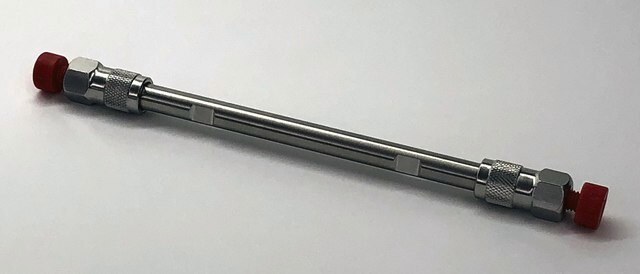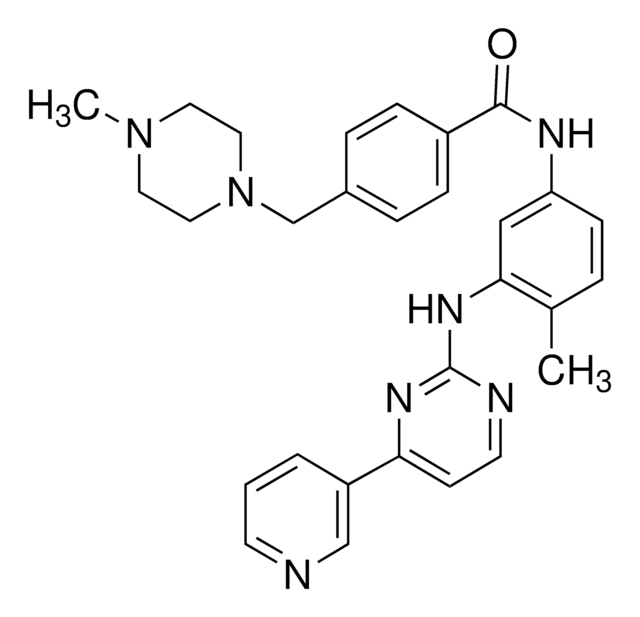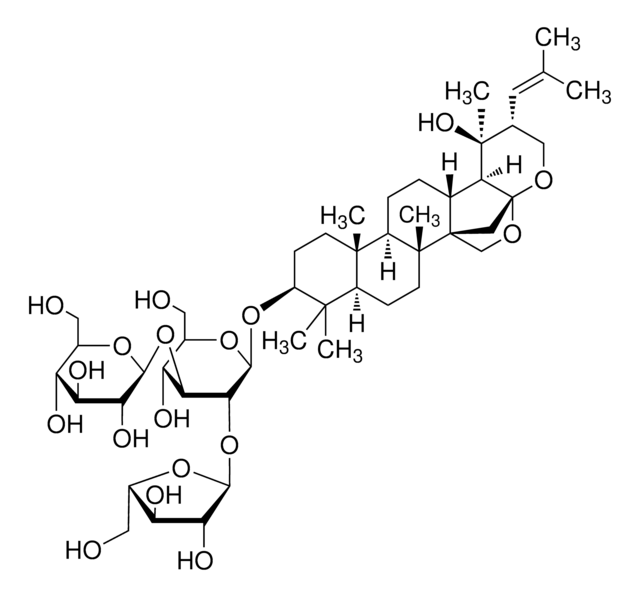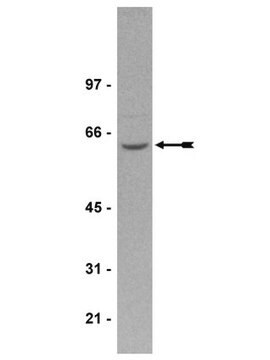PZ0240
(S)-Crizotinib
≥98% (HPLC)
동의어(들):
3-[(1S)-1-(2,6-Dichloro-3-fluorophenyl)ethoxy]-5-[1-(4-piperidinyl)-1H-pyrazol-4-yl]-2-pyridinamine
로그인조직 및 계약 가격 보기
모든 사진(1)
About This Item
실험식(Hill 표기법):
C21H22Cl2FN5O
CAS Number:
Molecular Weight:
450.34
MDL number:
UNSPSC 코드:
12352200
PubChem Substance ID:
NACRES:
NA.77
추천 제품
분석
≥98% (HPLC)
형태
powder
색상
white to beige
solubility
DMSO: 5 mg/mL, clear (warmed)
저장 온도
room temp
SMILES string
ClC1=C([C@H](C)OC2=C(N)N=CC(C3=CN(C4CCNCC4)N=C3)=C2)C(Cl)=C(F)C=C1
InChI
1S/C21H22Cl2FN5O/c1-12(19-16(22)2-3-17(24)20(19)23)30-18-8-13(9-27-21(18)25)14-10-28-29(11-14)15-4-6-26-7-5-15/h2-3,8-12,15,26H,4-7H2,1H3,(H2,25,27)/t12-/m0/s1
InChI key
KTEIFNKAUNYNJU-LBPRGKRZSA-N
생화학적/생리학적 작용
(S)-Crizotinib has a distinctly different profile from its (R)-enantiomer, the clinically approved anticancer agent Xalkori. Instead of targeting ALK, MET and ROS1, (S)-Crizotinib is a highly selective inhibitor of human 7,8-Dihydro-8-oxoguaninetriphosphatase MTH1 (NUDT1) with an IC50 value of 330 nM, 16-fold higher affinity towards MTH1 compared to the clinically used (R)-isomer. MTH1 hydrolyzes oxidized purine nucleoside triphosphates that might otherwise be incorporated into DNA/RNA and contribute to DNA damage. MTH1 removal of oxidized nucleotides that result from increased levels of reactive oxygen species (ROS) in fast-proliferating cancer cells helps protect cancer cells from proliferative stress and prevent cancer cell death. It is considered a new target for cancer therapy. In mouse xenograft studies using SW480 cells, (S)-crizotinib but not the (R)-enantiomer, was able to impair overall tumour progression as well as specifically reduce tumour volume by more than 50%.
Storage Class Code
11 - Combustible Solids
WGK
WGK 3
Flash Point (°F)
Not applicable
Flash Point (°C)
Not applicable
시험 성적서(COA)
제품의 로트/배치 번호를 입력하여 시험 성적서(COA)을 검색하십시오. 로트 및 배치 번호는 제품 라벨에 있는 ‘로트’ 또는 ‘배치’라는 용어 뒤에서 찾을 수 있습니다.
Melike Çağlayan et al.
Nature communications, 8, 14045-14045 (2017-01-10)
Oxidative stress in cells can lead to accumulation of reactive oxygen species and oxidation of DNA precursors. Oxidized purine nucleotides can be inserted into DNA during replication and repair. The main pathway for correcting oxidized bases in DNA is base
Xuanxuan Dai et al.
Journal of experimental & clinical cancer research : CR, 36(1), 120-120 (2017-09-09)
Non-small cell lung cancer (NSCLC) accounts for approximately 80-85% of all lung cancers and is usually diagnosed at an advanced stage with poor prognosis. Targeted therapy has produced unprecedented outcomes in patients with NSCLC as a number of oncogenic drivers
Peng Liu et al.
Nature communications, 10(1), 1486-1486 (2019-04-04)
Immunogenic cell death (ICD) converts dying cancer cells into a therapeutic vaccine and stimulates antitumor immune responses. Here we unravel the results of an unbiased screen identifying high-dose (10 µM) crizotinib as an ICD-inducing tyrosine kinase inhibitor that has exceptional antineoplastic
Stefan Nagel et al.
Oncotarget, 11(34), 3208-3226 (2020-09-15)
NKL homeobox genes encode developmental transcription factors and display an NKL-code according to their physiological expression pattern in hematopoiesis. Here, we analyzed public transcriptome data from primary innate lymphoid cells (ILCs) for NKL homeobox gene activities and found that ILC3
Liwei Dong et al.
OncoTargets and therapy, 8, 3649-3664 (2015-12-18)
Inhibition of the nucleotide pool sanitizing enzyme MTH1 causes extensive oxidative DNA damages and apoptosis in cancer cells and hence may be used as an anticancer strategy. As natural products have been a rich source of medicinal chemicals, in the
자사의 과학자팀은 생명 과학, 재료 과학, 화학 합성, 크로마토그래피, 분석 및 기타 많은 영역을 포함한 모든 과학 분야에 경험이 있습니다..
고객지원팀으로 연락바랍니다.








